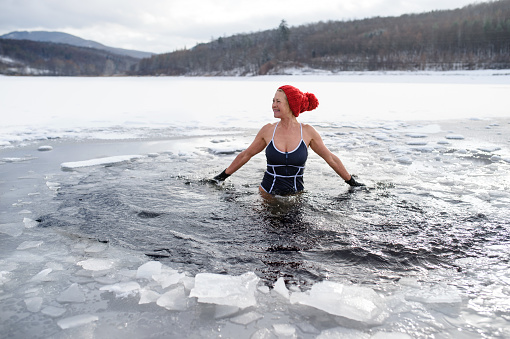Ice baths have been used for years to heal sore muscles and reduce pain. The benefits of an ice bath include reducing muscle spasms and preventing swelling.
After working up a sweat, dipping into an ice bath is a great method to restore your body’s natural temperature.
Basically, it’s simply a tub of ice and water. You go in the tub and remain there for 10 to 15 minutes. After strenuous activity, this might assist your body chill down and speed up the recovery process.
It is also possible to utilize ice baths as a treatment for injuries, however doing so without medical supervision is not advised since it might do more harm than good.
Table of Contents
What is an Ice Bath?

A mixture of water and ice is what’s known as an ice bath or cold bathing. Ice baths are brief, curative dips in water that is between 50 and 59 degrees Fahrenheit and range from 50 to 59 degrees Fahrenheit in temperature.
Putting it into practice is as easy as putting three enormous bags of ice into a bathtub that is just half full of chilly water. You might use a smaller tub if you were just going to apply it to a portion of the body, like the wrist or the elbow, for example.
The theory of an ice bath after intense exercise
Microtrauma refers to the microscopic tears that are caused in the muscle fibers as a result of intense exercise. Because of this, the muscles are stimulated, healed, and strengthened all at the same time. As your muscles use up energy, they produce lactic acid and other wastes, which can lead to muscular stiffness and soreness if they are allowed to accumulate. Within 24 to 72 hours, it will be eradicated on its own by natural means. This process may be sped up with the use of an ice bath, which thus significantly cuts down on the amount of time needed for recuperation.
When you submerge yourself in cold water, the stress reactions in your brain send a signal to your body to try to recover its core temperature by boosting blood flow to that area of the body. The quick flushing of toxins is facilitated by the arrival of newly oxygenated blood. Your muscle healing will go more quickly as a result of this. This takes place as a result of the “fight or flight” reaction that the body has.
The benefits of an ice bath
Benefits of an ice bath includes boosting your mood
By stimulating the body’s natural “fight or flight” reaction, exposure to cold water can set off a cascade of chemicals in the brain that has the effect of elevating a person’s mood.
This response to ‘environmental stress’ conditions our brain to cope better with the pressures of everyday life and helps decrease the production of inflammatory cytokines, which are connected to anxiety and depression. In addition, our brain is better able to deal with the stressors of everyday life.
You can train your body to become more resistant to the negative effects of stress by acclimating it to cooler temperatures.
Benefits of an ice bath helps in swelling and inflammation
Your blood vessels contract when you sit in cold water. This constriction is supposed to alleviate post-workout edema and inflammation, which can cause discomfort and muscle breakdown following exertion.
Benefits of an ice bath helps in muscle pain
There is preliminary evidence that, as compared to standard rest, cold water immersion helps reduce delayed onset muscle soreness following severe physical activity. This is supposed to be owing to cold water’s pain-relieving properties.
Benefits of an ice bath show improve in performance
Despite inconsistent evidence, most athletes use cold water immersion to boost their performance. There is some potential for increased sprint speed and muscle strength, albeit this is likely to depend on the precise protocol, such as temperature and duration of immersion, as well as other aspects, such as diet and hydration.
Benefits of an ice bath also enhances mental health
Ice baths may also be beneficial to your mental health. A tiny study indicated that taking a 20-minute ice bath four days a week enhanced gout patients’ quality of life. They had improved joint mobility and were less stressed, anxious, and depression. According to scientists, cold water causes a stress response and activates the neurological system. These modifications can help you improve your mood and adjust to stress over time.
Benefits of an ice bath gives you a restful sleep
The brain and neurological system initiate and regulate sleep behaviors, and ice bath therapy has been demonstrated to influence both directly. Your body can calm down after the initial cold water temperature shock and becomes more robust to changes in your surroundings.
This translates to you developing a stronger tolerance to stress by controlling your cortisol levels, which aids in the treatment of depressive symptoms and the prevention of sleep-related illnesses.
Other benefits of an ice bath have been found to be:

- Regulates central nervous system
- Improves Resilience
- Shifts your immune system
- Cardiovascular Circulation
- May enhance performance
- Improves discipline
- Prevent the risk of injury
Tips to take an Ice Bath
If you’re ready to leap, you should know a few things before diving into the ice.
Ice Bath temperature

The temperature of an ice bath should be around 10-15° Celsius (50-59° Fahrenheit).
Time spent in an ice bath
Spending too much time in an ice bath can be dangerous. That is why you should limit your time to 10 to 15 minutes.
Body exposition
Immersing your entire body in an ice bath to maximize the effect of blood vessel constriction.
First, you should expose your feet and lower legs. You can move closer to your chest as you become more at ease.
Bathing Schedule
The sooner you get into an ice bath following a workout or competition, the better the results should be.
If you wait an hour after your workout, some healing and inflammatory processes will have begun or been completed.
Some Potential disadvantages and risk
Frost bite and hypothermia
Prolonged exposure to excessive heat or cold may be harmful to the body. Staying in an ice bath for more than 15 minutes is not recommended if you take a plunge. Pay attention to your body. It’s time to get out if you’re feeling exhausted or your skin is changing colors.
Painful experience
Entering a cold bath is not for the faint of heart, especially if you do it rapidly. If the pain does not go away after a few minutes, add more water or leave.
Cardiovascular illness
Consult your doctor first if you have a cardiovascular disease.
FAQs
How long should you stay in an ice bath?
There are no absolute rules. Water temperatures ranging from 50 to 59 degrees F have been employed in several studies. You should limit your stay to 15 minutes, though this varies according to the individual, as tolerance grows over time. When you begin to shake or shiver, get out.
Are ice baths good for you?
The answer is yes. There are many benefits of an ice bath, but not everyone enjoys the same results. Because of its anti-inflammatory and anti-swelling effects, ice baths can be useful pain relievers. They aid in post-workout recovery by decreasing lactic acid accumulation. Yet, moderation is key. The risks of hypothermia and frostbite increase with prolonged exposure to an ice bath.
Do ice baths burn fat?
Yes! Ice baths are an effective method to burn fat. Ice baths, also known as cold thermogenesis, may aid fat loss. When exposed to frigid temperatures for an extended amount of time, the body begins to burn more calories than it normally would. This is because your body must work more than usual to maintain a lower temperature. The more calories burned throughout this procedure, the more body fat you will shed.
Conclusion
According to some studies, benefits of an ice bath aid in muscle healing and give various health benefits, such as stress reduction and mood enhancement. However, the study remains contentious and inconclusive.
Ice baths should be avoided by people who have type 1 or type 2 diabetes, previous cardiovascular disease, or excessive blood pressure. If you intend to jump, limit yourself to no more than 10 to 15 minutes.

